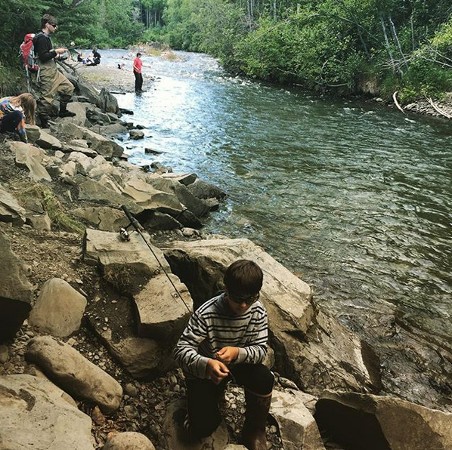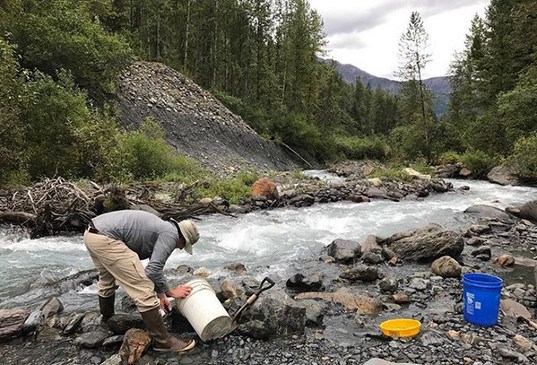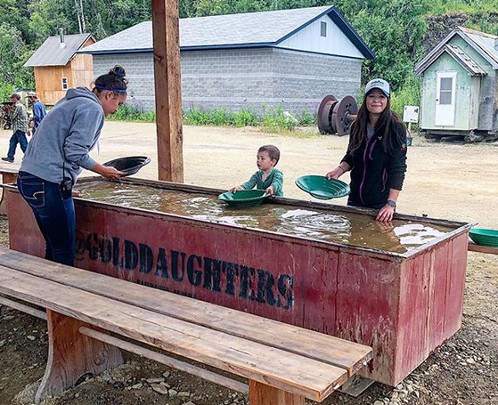Alaska is a state founded on gold panning. Prior to the Klondike Gold Rush, the state was almost entirely inhabited by indigenous people. It also holds the distinction of being the final American state in which gold was discovered. This, at least in theory, means that it has more undiscovered gold than more heavily mined American land. Today prospectors pan Alaskan waters hoping to claim some of that gold for themselves.
- Lode Gold in Alaska
- Prospecting Rules and Regulations
- Best Time of Year to Prospect
- Best Areas for Prospecting
Lode Gold in Alaska
If you're not satisfied with the fine placer gold of many other states, then Alaska may be the state for you.
Lode gold was reported throughout the Klondike Gold Rush. In 1903, Anvil Creek produced a nugget weighing 182 troy ounces. In 1998, the Alaska Centennial Nugget was discovered. Extracted from Swift Creek, this nugget came in at 294 troy ounces. Because it was discovered somewhat recently, many cite the Alaska Centennial Nugget as proof that significant nuggets can still be found in the state. But Alaska isn't all lode gold. Placer gold is frequently extracted from its rivers by recreational prospectors.
Prospecting Rules and Regulations
Alaska's gold prospecting laws are fairly lax. This is one reason why so many prospectors venture to the state. Panning doesn't require a permit and neither does a sluice box. In the national parks, only a gold pan is allowed.
When prospecting in Alaska you need to be careful not to disturb historic sites. Otherwise you can be put you in violation of the Federal Antiquities Act. Normally this law extends only to properties that are over 100 years old, but authorities in Alaska take the Federal Antiquities Act seriously. The State has been known to pursue those who disturb sites less than 100 years old if they are considered "historically significant".
Mining claims also need to be considered, and Alaska has plenty of them. It's easy to trespass on one of these claims without even realizing it. In order to avoid inadvertently prospecting on private property, you should contact the Bureau of Land Management's Alaska Department. The BLM will point you towards patches of Alaskan land that are claim-free and safe for the public to pan.
Best Time of Year to Prospect
Prospecting in Alaska is notoriously taxing. Even some tough veterans have found its environment too much to withstand. If you want success in Alaska, there are a few points to keep in mind. Prospecting season in the state is brief. The season runs from May to September. You should limit your prospecting to these months regardless of your level of experience. If you attempt to pan for gold out of season in Alaska then you'll have to contend with the state's infamously treacherous weather conditions.
Best Areas for Prospecting
Gold has been reported throughout Alaska. But as with any gold-bearing state, some regions are richer than others. Below we'll examine the areas of Alaska's most noteworthy gold discoveries. Each area remains a reliable producer of gold to this day.
Hope

Aptly named, Hope is a small town of less than 200 people. It was founded in 1896 by prospectors who came to Alaska after hearing reports of gold. To this day it still attracts prospectors from America and abroad.
Located in the Kenai Pennusinal, Hope is home to the mouth of Resurrection Creek. It was here that some of the earliest discoveries of gold in Alaska were made. Even today panning in Resurrection Creek may prove fruitful. The creek still boasts enough gold to justify several commercial mining operations in Hope.
Hope is also not far removed from Indian Valley Mine. This Mine is a popular spot among Anchorage tourists and it's a great place to learn about the region's gold mining past.
Petersville
If you want to pan without fear of trespassing, then you should go to Petersville. A town of less than a dozen people, Petersville is home to the Petersville Mining Area.
The Petersville Mining Area is located on government land and dedicated entirely to recreational prospecting. Notable amounts of placer and lode gold have been extracted from the Petersville Mining Area over the years, and it's possible that more notable amounts remain waiting to be uncovered. Non-motorized equipment is preferred at this site. While suction dredging is allowed, it requires a permit from the Alaska Department of Fish and Game.
Girdwood

Girdwood is another Alaskan town that owes its existence to gold prospecting. Founded in 1896, it produced some of the most significant finds of the Klondike Gold Rush. The heart of Girdwood's prospecting is the Crow Creek Mine.
Years ago the Crow Creek Mine produced 700 ounces of gold per month. As gold fever subsided, the mine's popularity declined and commercial operations were later ceased with the onset of World War Two. Today Crow Creek Mine is open to the public for recreational gold panning. Meanwhile, a small museum displays equipment used by the mine's earliest prospectors. Visitors also have the opportunity to visit the area's many historic buildings and hiking trails. With everything that it has to offer, Crow Creek Mine makes for a great day out. It has become a popular site among hobbyist panners making a trip to Alaska with their families.
Fairbanks

With a population of more than 32,700, Fairbanks is the largest city in Alaska's interior region. Fairbank's population is due to the success of early prospectors in the area. Today the city is home to a number of businesses looking to capitalize on its history. Perhaps the most noteworthy of these businesses is Gold Daughters.
Gold Daughters offers a guided panning experience. Adults and children alike are provided with an extensive panning lesson. They are then given the opportunity to pan for gold with the promise of success. Experienced panners are unlikely to get anything from the experience. Still, novice panners should definitely consider visiting Gold Daughters if they find themselves in Fairbanks. Note that this business is closed during the winter months.
Conclusion
The state of Alaska has a a lot to offer prospectors. It boasts significant amounts of lode and placer gold. Major discoveries have been reported as recently as the turn of the millennium.
In Alaska there are plenty of organized panning areas. These areas are great if you're new to the hobby. There are also public prospecting spots which can yield good results. Remember that out-of-towners should plan to visit only in the warmer months. Prospecting in cold weather is not ideal.
